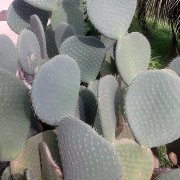Care of the cactus Opuntia spinulifera or Saucepan cactus |
|
The genus Opuntia, family Cactaceae, includes some 300 species of cacti originating in Mexico, the USA and Central and South America. Some species are: Opuntia spinulifera, Opuntia santa-rita, Opuntia rufida, Opuntia robusta, Opuntia polyacantha, Opuntia microdasys, Opuntia linguiformis, Opuntia leucotricha, Opuntia engelmannii, Opuntia bergeriana, Opuntia ficus-indica, Opuntia durangensis, Opuntia subulata, Opuntia atrispina, Opuntia aciculata, Opuntia auberi, Opuntia valida, Opuntia macrocentra, Opuntia chlorotica, Opuntia lindheimeri, Opuntia basilaris, Opuntia vestita. Common names: Saucepan cactus, Large roundleaved prickly pear. This species is native to central Mexico. They are arboreal or shrubby cactus with a short trunk covered with hairs that can reach 1 meter (3.28 feet) in height. The segments are rounded, grayish green in color and have circular areoles with 1-4 spines 1.5 cm (0.59") long. They produce showy yellow flowers. They bloom in spring. Saucepan cactus is used in rockery, as isolated specimens, in cactus and succulent gardens or to form barriers. If winter is very cold, it's advisable to grow it in pots to be able to protect it. Opuntia spinulifera grows in full sun or light shade exposure. It prefers warm, frost-free climates. The soil can be a mixture, in the same proportions, of coarse sand and leaf mulch. Water moderately in summer waiting for the substrate to be dry. In spring and autumn water once a month. Do not water in winter. Fertilize with compost in early spring and mineral cactus fertilizer in early summer. Large roundleaved prickly pear does not need pruning. Opuntia spinulifera is very resistant to pests and diseases but sensitive to excess water. Saucepan cactus is easily propagated by segment cuttings in spring or summer. |
Images of the cactus Opuntia spinulifera or Saucepan cactus |
Find plants
Opuntia spinulifera or Saucepan cactus | Care and Growing
© 2026 FavThemes




